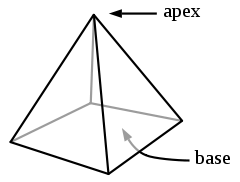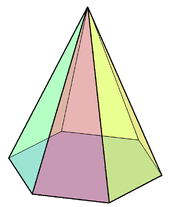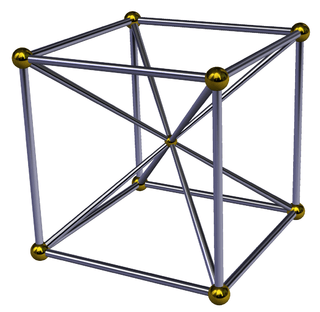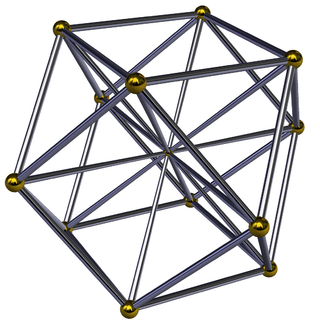Pyramid (geometry)
| Set of pyramids | |
|---|---|
 | |
| Schläfli symbol | { } v {n} |
| Faces | n triangles, 1 n-gon |
| Edges | 2n |
| Vertices | n + 1 |
| Symmetry group | Cnv, [1,n], (*nn), order 2n |
| Rotation group | Cn, [1,n+], (nn), order n |
| Dual polyhedron | Self-dual |
| Properties | convex |

In geometry, a pyramid is a polyhedron formed by connecting a polygonal base and a point, called the apex. Each base edge and apex form a triangle. It is a conic solid with polygonal base.
A pyramid with an n-sided base will have n + 1 vertices, n + 1 faces, and 2n edges. All pyramids are self-dual.
When unspecified, the base is usually assumed to be square.
If the base is a regular polygon and the apex is above the center of the polygon, an n-gonal pyramid will have Cnv symmetry.
If all edges of a pyramid (or any convex polyhedron) are tangent to a sphere so that the average position of the tangential points are at the center of the sphere, then the pyramid is said to be canonical, and it forms half of the dual polyhedron of a cube.
Pyramids are a subclass of the prismatoids.
Pyramids with regular polygon faces
The trigonal or triangular pyramid with all equilateral triangles faces becomes the regular tetrahedron, one of the Platonic solids. A lower symmetry case of the triangular pyramid is C3v which has an equilateral triangle base, and 3 identical isosceles triangle sides. The square and pentagonal pyramids can also be composed of regular convex polygons, in which case they are Johnson solids.
| Tetrahedron | Square pyramid | Pentagonal pyramid | Hexagonal pyramid |
|---|---|---|---|
 |
 |
 |
 |
Star pyramids
Pyramids with regular star polygon bases are called star pyramids.[1] For example, the pentagrammic pyramid has a pentagram base and 5 intersecting triangle sides.
Volume
The volume of a pyramid (also any cone) is  where b is the area of the base and h the height from the base to the apex. This works for any polygon, regular or non-regular, and any location of the apex, provided that h is measured as the perpendicular distance from the plane which contains the base. In 499 AD Aryabhata, a mathematician-astronomer from the classical age of Indian mathematics and Indian astronomy, used this method in the Aryabhatiya (section 2.6).
where b is the area of the base and h the height from the base to the apex. This works for any polygon, regular or non-regular, and any location of the apex, provided that h is measured as the perpendicular distance from the plane which contains the base. In 499 AD Aryabhata, a mathematician-astronomer from the classical age of Indian mathematics and Indian astronomy, used this method in the Aryabhatiya (section 2.6).
The formula can be formally proved using calculus: By similarity, the linear dimensions of a cross section parallel to the base increase linearly from the apex to the base. The scaling factor (proportionality factor) is  , or
, or  , where h is the height and y is the perpendicular distance from the plane of the base to the cross-section. Since the area of any cross section is proportional to the square of the shape's scaling factor, the area of a cross section at height y is b×
, where h is the height and y is the perpendicular distance from the plane of the base to the cross-section. Since the area of any cross section is proportional to the square of the shape's scaling factor, the area of a cross section at height y is b× , or since both b and h are constants
, or since both b and h are constants 
 . The volume is given by the integral
. The volume is given by the integral
The same equation,  , also holds for cones with any base. This can be proven by an argument similar to the one above; see volume of a cone.
, also holds for cones with any base. This can be proven by an argument similar to the one above; see volume of a cone.
For example, the volume of a pyramid whose base is an n-sided regular polygon with side length s and whose height is h is:
The formula can also be derived exactly without calculus for pyramids with rectangular bases. Consider a unit cube. Draw lines from the center of the cube to each of the 8 vertices. This partitions the cube into 6 equal square pyramids of base area 1 and height 1/2. Each pyramid clearly has volume of 1/6. From this we deduce that pyramid volume = height * base area / 3. This is exact.
Next, expand the cube uniformly in three directions by unequal amounts so that the resulting rectangular solid edges are a, b and c, with solid volume abc. . Each of the 6 pyramids within are likewise expanded. And—each pyramid has the same volume abc/6. Since pairs of pyramids have heights a/2, b/2 and c/2 we see that pyramid volume = height * base area / 3 again.
Surface area
The surface area of a pyramid is  where B is the base area, P is the base perimeter and L is the slant height
where B is the base area, P is the base perimeter and L is the slant height
 where h is the pyramid altitude and r is the inradius of the base.
where h is the pyramid altitude and r is the inradius of the base.
n-dimensional pyramids
A 2-dimensional pyramid is a triangle, formed by a base edge connected to a noncolinear point called an apex.
A 4-dimensional pyramid is called a polyhedral pyramid, constructed by a polyhedron in a 3-space hyperplane of 4-space with another point off that hyperplane.
Higher dimensional pyramids are constructed similarly.
The family of simplices represent pyramids in any dimension, increasing from triangle, tetrahedron, 5-cell, 5-simplex, ... A n-dimensional simplex has the minimum n+1 vertices, with all pairs of vertices connected by edges, all triples of vertices defining faces, all quadruples of points defining tetrahedral cells, etc.
Polyhedral pyramid
In 4-dimensional geometry, a polyhedral pyramid is a polychoron constructed by a base polyhedron cell and an apex point. The lateral facets are pyramid cells, each constructed by one face of the base polyhedron and the apex.
The regular 5-cell (or 4-simplex) is an example of a tetrahedral pyramid. Uniform polyhedra with circumradii less than 1 can be make polyhedral pyramids with regular tetrahedral sides. A polyhedron with v vertices, e edges, and f faces can be the base on a polyhedral pyramid with v+1 vertices, e+v edges, f+e faces, and 1+f cells.
A 4D polyhedral pyramid with axial symmetry can be visualized in 3D with a Schlegel diagram which is a 3D projection that places the apex at the center of the base polyhedron.
| [3,3,1] | [4,3,1] | [5,3,1] | ||||
|---|---|---|---|---|---|---|
| { } v {3,3} | { } v t{3,3} | { } v {4,3} | { } v r{4,3} | { } v {3,4} | { } v {5,3} | { } v {3,5} |
 Tetrahedron |
 Truncated tetrahedron |
 Cube |
 Cuboctahedron |
 Octahedron |
 Dodecahedron |
 Icosahedron |
Any convex polychoron can be divided into polyhedral pyramids by adding an interior point and creating one pyramid from each facet to the center point. This can be useful for computing volumes.
Volume
The 4-dimensional volume of a polyhedral pyramid is 1/4 of the volume of the base polyhedron times its perpendicular height, compared to the area of a triangle being 1/2 the length of the base times the height and the volume of a pyramid being 1/3 the area of the base times the height.
See also
References
- ↑ Wenninger, Magnus J. (1974), Polyhedron Models, Cambridge University Press, p. 50, ISBN 978-0-521-09859-5.
External links
| Wikimedia Commons has media related to Pyramids (geometry). |
- Weisstein, Eric W., "Pyramid", MathWorld.
- Olshevsky, George, Pyramid at Glossary for Hyperspace.
- The Uniform Polyhedra
| ||||||||||||||||||||||||||||


